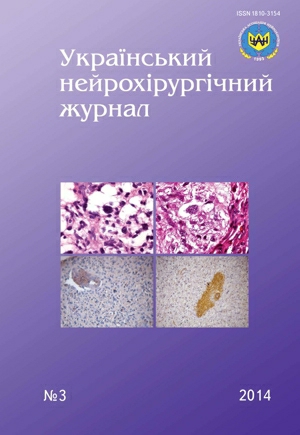Modern approaches to vestibular schwannomas treatment in patients with neurofibromatosis type 2 using stereotactic radiosurgery
DOI:
https://doi.org/10.25305/unj.47497Keywords:
vestibular schwannoma, neurofibromatosis type 2, stereotactic radiosurgeryAbstract
Introduction. The results and efficacy of stereotactic radiosurgery (SRS) in treatment of patients with vestibular shwannomas (VS) associated with neurofibromatosis type 2 (NF2) are analyzed.
Materials and methods. In 12 patients with NF2 (in total 17 VS) 15 VS-NF2 were irradiated using linear accelerator Trilogy. The prescribed doze (PD) for VS-NF2 was 12.0 – 13.0 Gy (median 12.5 Gy, in average 12.5 Gy); maximal doze — from 13.01 to 15.0 Gy (median 14.31 Gy, in average 14.19 Gy); targets volume — from 0.226 to 8.258 cm3 (median 3.564 cm3, in average 3.61 cm3).
Results. In 15 VS-NF2, treated with SRS, local control was achieved in 93%. In 7 patients after SRS there were no negative changes in neurological state, in 4 of them positive clinical dynamics was observed. Hearing preservation rate was 57%. After SRS occlusive hydrocephalus, resistant trigeminal pain, aggravation of facial nerve dysfunction were not identified.
Conclusions. SRS is non-invasive method of VS-NF2 treatment, it provides local control and preservation of cranial nerves function adjacent to the tumor.
References
Baser M, R. Evans D, Gutmann D. Neurofibromatosis 2. Current Opinion in Neurology. 2003;16(1):27-33. [CrossRef] [PubMed]
Vranceanu AM, Merker VL, Park E, Plotkin SR. Quality of life among adult patients with neurofibromatosis 1, neurofibromatosis 2 and schwannomatosis: a systematic review of the literature. J. Neuro-Oncol. 2013;114(3):257-262. [CrossRef] [PubMed]
Barcovich AJ, Raybaud C. Pediatric neuroimaging. Philadelphia: Lippincott Williams and Wilkins, 2012. p.1125.
Neely JG, Britton BH, Greenberg SD. Microscopic characteristics of the acoustic tumor in relationship of its nerve of origin. The Laryngoscope. 1976;86(7):984-991. [CrossRef] [PubMed]
Evans DGR, Baser ME, O’Reilly B, Rowe J, Gleeson M, Saeed S, King A, Huson SM, Kerr R, Thomas N, Irving R, MacFarlane R, Ferner R, McLeod R, Moffat D, Ramsden R. Management of the patient and family with neurofibromatosis 2: a consensus conference statement. British Journal of Neurosurgery. 2005;19(1):5-12. [CrossRef] [PubMed]
M.J. Link, C. Driscol, R.L. Foote, B.E. Pollock. Radiation therapy and radiosurgery for vestibular schwannomas: Indications, techniques, and results. Otolaryngol. Clin. N. Am. 2012;45(2):353-366. [CrossRef] [PubMed]
Regis J, Carron R, Delsanti C, Porcheron D, Thomassin JM, Murracciole X, Roche PH. Radiosurgery for vestibular schwannomas. Neurosurg. Clin. N. Am. 2013;24(4):521-530. [CrossRef] [PubMed]
Lustgarten L. The impact of stereotactic radiosurgery in the management of neurofibromatosis type 2-related vestibular schwannomas. Surg. Neurol. Int. 2013;4(3):151-155. [CrossRef] [PubMed]
Massager N, Delbrouck C, Masudi J, De Smedt F, Devriendt D. Hearing preservation and tumour control after radiosurgery for NF2-related vestibular schwannomas. B-ENT. 2013;9(1):29-36. [PubMed]
Myrseth E, Moller P, Pedersen PH, Lund-Johansen M. Vestibular schwannoma: Surgery or gamma knife radiosurgery? A prospective, nonrandomized study. Neurosurgery. 2009;64(4):654-663. [CrossRef] [PubMed]
Sarmiento JM, Patel S, Mukherjee D, Patil CG. Improving outcomes in patients with vestibular schwannomas: Microsurgery versus radiosurgery. J. Neurosurg. Sci. 2013;57(1):23-44. [PubMed]
Shaheryar AF, Terry C, Cohen-Gadol AA. Surgery for vestibular schwannomas: a systematic review of complications by approach. Neurosurg. Focus. 2012;33(3):14. [CrossRef] [PubMed]
Regis J, Roche P-H. Modern management of acoustic neuroma. Basel: Karger; 2008. p.261.
Kim YH, Kim DG, Han JH, Chung HT, Kim IK, Song SW, Park JH, Kim JW, Kim YH, Park CK, Kim CY, Paek SH, Jung HW. Hearing outcomes after stereotactic radiosurgery for unilateral intracanalicular vestibular schwannomas: Implication of transient volume expansion. Int. J. Radiat. Oncol. Biol. Physics. 2013;85(1):61-67. [CrossRef] [PubMed]
Rodriguez-Mena R, Gallego-Sanchez JM, Gonzalez-Bonet LG, Goig-Revert F, Barcia-Marino C, Rosello-Ferrando J. Linear accelerator radiosurgery for the treatment of vestibular schwannoma. Rev. Neurol. 2011;52(5):275-282. [PubMed]
Mallory GW, Pollock BE, Foote RL, Carlson ML, Driscoll CL, Link MJ. Stereotactic radiosurgery for neurofibromatosis 2-associated vestibular schwannomas: Toward dose optimization for tumor control and functional outcomes. Neurosurgery. 2014;74(3):282-292. [CrossRef] [PubMed]
Downloads
Published
How to Cite
Issue
Section
License
Copyright (c) 2014 Oksana Zemskova, Olga Chuvashova

This work is licensed under a Creative Commons Attribution 4.0 International License.
Ukrainian Neurosurgical Journal abides by the CREATIVE COMMONS copyright rights and permissions for open access journals.
Authors, who are published in this Journal, agree to the following conditions:
1. The authors reserve the right to authorship of the work and pass the first publication right of this work to the Journal under the terms of Creative Commons Attribution License, which allows others to freely distribute the published research with the obligatory reference to the authors of the original work and the first publication of the work in this Journal.
2. The authors have the right to conclude separate supplement agreements that relate to non-exclusive work distribution in the form of which it has been published by the Journal (for example, to upload the work to the online storage of the Journal or publish it as part of a monograph), provided that the reference to the first publication of the work in this Journal is included.









